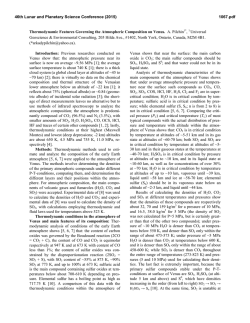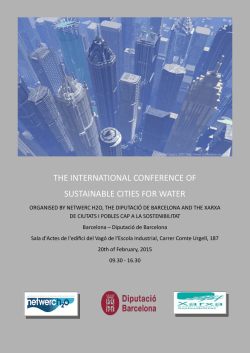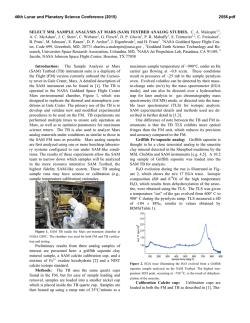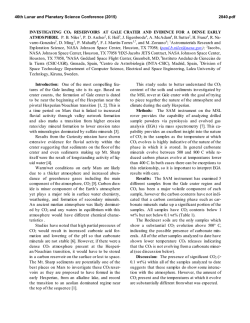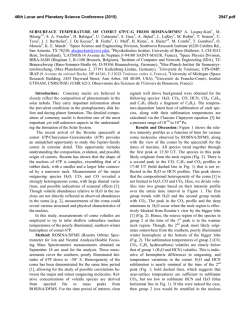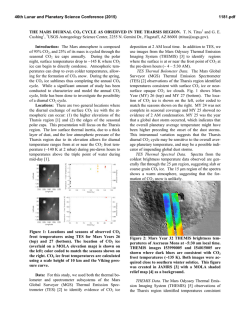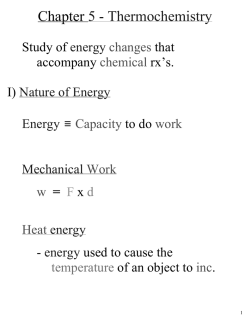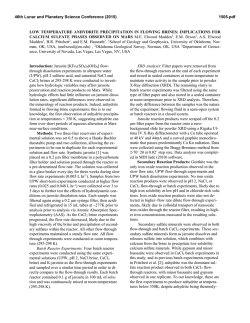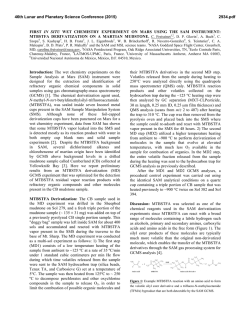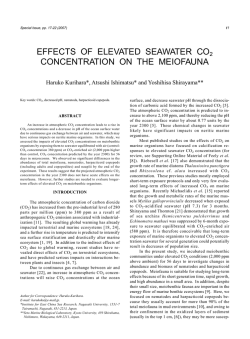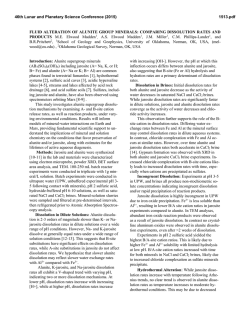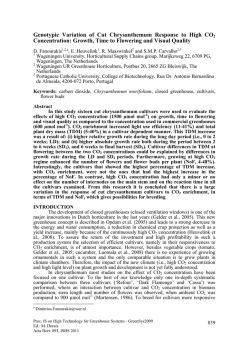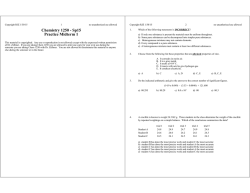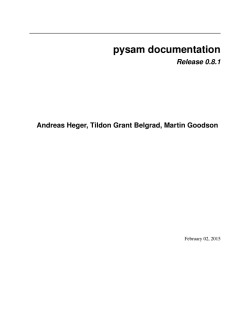
MAJOR VOLATILES FROM MSL SAM EVOLVED - USRA
46th Lunar and Planetary Science Conference (2015) 2323.pdf MAJOR VOLATILES FROM MSL SAM EVOLVED GAS ANALYSES: YELLOWKNIFE BAY THROUGH LOWER MOUNT SHARP. A.C. McAdam1, P.D. Archer, Jr.2, B. Sutter2, H.B. Franz1,3, J.L. Eigenbrode1, D.W. Ming4, R.V. Morris4, P.B. Niles4, J.C. Stern1, C. Freissinet1, D.P. Glavin1, S.K. Atreya5, D.L. Bish6, D.F. Blake7, P.R. Mahaffy1, R. Navarro-Gonzalez8, C.P. McKay7, M.B. Wilhelm7,9, and the MSL Science Team. 1NASA Goddard Space Flight Center, Greenbelt, MD 20771, [email protected], 2Jacobs, NASA Johnson Space Center, Houston, TX 77058, 3Univ. of Maryland, Baltimore, MD 21228 4NASA Johnson Space Center, Houston, TX, 77058, 5Univ. of Michigan, Ann Arbor, MI, 6 Dept. of Geological Sci., Indiana Univ., Bloomington, IN 47405, 7NASA Ames Research Center, Moffett Field, CA 94035, 8 Universidad Nacional Autónoma de México, México, D.F. 04510, 9Georgia Inst. Tech., Atlanta, GA, 94043. Introduction: The Sample Analysis at Mars (SAM) and Chemistry and Mineralogy (CheMin) instruments on the Mars Science Laboratory (MSL) analysed several subsamples of <150 µm fines from five sites at Gale Crater. Three were in Yellowknife Bay: the Rocknest aeolian bedform (“RN”) and drilled Sheepbed mudstone from sites John Klein (“JK”) and Cumberland (“CB”). One was drilled from the Windjana (“WJ”) site on a sandstone of the Kimberly formation investigated on route to Mount Sharp. Another was drilled from the Confidence Hills (“CH”) site on a sandstone of the Murray Formation at the base of Mt. Sharp (Pahrump Hills). Outcrops are sedimentary rocks that are largely of fluvial or lacustrine origin, with minor aeolian deposits [1,2]. SAM’s evolved gas analysis (EGA) mass spectrometry detected H2O, CO2, O2, H2, SO2, H2S, HCl, NO, and other trace gases, including organic fragments [3]. The identity and evolution temperature (T) of evolved gases can support CheMin mineral detection and place constraints on trace volatile-bearing phases or phases difficult to characterize with XRD (e.g., X-ray amorphous phases). They can also give constraints on sample organic chemistry. Here, we discuss trends in major evolved volatiles from SAM EGA analyses to date. Methods: Fines were heated to ~835-900oC depending on the run, at 35oC/min, under ~25 mb of He. Evolved gases were carried in helium at ~0.8 sccm to the QMS. To investigate aspects of the flight SAM data, several laboratory systems are used to characterize analogs under SAM-like conditions. H2O: Water was the most abundant volatile evolved from RN, JK and CB [4,5]. The overall shape of the H2O traces is similar for all samples, except for the high T evolution near 750oC for JK and CB and the shoulder at ~450oC in the CH trace (Fig. 1). Most H2O comes off in a wide peak <~450oC. This H2O has many potential sources, including adsorbed H2O, smectite interlayer H2O, H2O/OH from bassanite and akaganeite (identified by CheMin in some samples), H2O from minor hydrated minerals like oxychlorine phases (inferred from SAM) and H2O/OH from amorphous phases (CheMin detected ~30 wt% amorphous material in all samples [6-9]). The shoulder at ~450oC in the CH trace likely results mainly from dehyroxyla- tion of the <1 wt % jarosite detected by CheMin [9]. The ~750oC peak in CB and JK traces reFigure 1. Sample H2O EGA-MS traces. sults from the dehydroxylation of the ~20 wt % smectite clay detected by CheMin. Comparison with SAM-like lab data indicates that a trioctahedral smectite, such as Fesaponite, is most consistent with the high T H2O observed, consistent with CheMin observations [10]. Although ~10 wt % of an ~10 Å phyllosilicate was inferred from WJ and CH CheMin data and possibly results from a collapsed smectite [8,9], SAM H2O traces do not display a distinct high T dehydroxylation peak, though there is some H2O being evolved at high Ts (Fig. 1). Lack of a peak may result from the lower phyllosilicate abundances compared to CB and JK. SO2: More SO2 evolved from WJ and CH than CB, JK and RN. All samples evolved SO2 from 500800oC, but JK and CB exhibited an additional evolution near 300oC (Fig. 2). CheMin analyses revealed ~1 wt% pyrrhotite (and possibly <1 wt % pyrite in JK), and several wt% Ca sulfates (which do not typically decompose in the SAM T Figure 2. Sample SO2 EGA-MS traces. range) [6]. The ~300oC SO2 evolution is coincident with an O2 evolution and likely results from partial oxidation of the sulfide. Some SO2 evolved from 500–700oC also likely results from sulfide oxidation, based on analog work [11]. In RN and WJ, no sulfur minerals expected to decompose in the SAM T range were detected by CheMin. As a result, SO2 is likely evolved from the amorphous component and potentially trace S minerals. More SO2 evolved from WJ, implying more trace 46th Lunar and Planetary Science Conference (2015) S-phases (some Fe- and Al sulfates, sulfites, sulfides evolve SO2 at relevant Ts) or more S associated with the amorphous component. In CH, the only sulfur mineral detected was jarosite. SO2 evolution near 580oC (Fig. 2) is consistent with SAM-like analyses of jarosite. The <1 wt% jarosite detected cannot account for all the SO2 evolved (or detected by APXS). This SO2, including SO2 evolved at higher T including a ~775oC peak, must be associated with the amorphous phase and possibly with trace sulfur minerals. Some Al sulfates, for example, evolve SO2 near 775oC and are consistent with acidic conditions needed to form jarosite. O2: All samples evolved O2 at Ts below ~500oC (Fig. 3). These O2 releases, together with detections of HCl and chlorinated hydrocarbons (not shown) are evidence of oxychlorine phases such as perchlorates or chlorates [e.g., 5]. The O2 evolution is different for each sample. In JK there are two peaks, sugFigure 3. Sample O2 EGA-MS traces. gesting different phases or reactions during heating (oxidation of organic compounds, reaction with reduced Fe phases) [5]. For RN and the second JK peak, the O2, and HCl, evolutions, are consistent with a Ca-chlorate, or Mg- or Ca-perchlorate mixed with ferrihydrite or palagonitic materials [5,12-14]. For CH, they are consistent with Mg- or Ca-perchlorate mixed with hematite or magnetite [14]. For the first JK peak, Fe perchlorates evolve O2 at similar Ts [5]. For CB and WJ, O2 evolutions do not match those from any common perchlorate or chlorate but mixtures with relevant minerals may shift O2 evolution Ts [e.g. 12,14]. In CH alone, O2 evolution was observed near 775 o C - a higher T than expected from perchlorate or chlorate decompositions. There are several possible explanations for this including sulfate decomposition, gasphase reactions at high T, etc., and work is ongoing. CO2: All samples evolved CO2 below ~600oC. There are several possible causes. For RN, CH, and the high T shoulder of JK between ~400 and 600oC CO2 could be related to decomposition of a fine-grained Fe/Mg carbonate [e.g., 4,5]. For JK, CB, CH, and WJ, coincidence of CO2 and O2 evolutions, often associated with decreases in the signal from masses associated with organic fragments, suggests combustion of organic compounds. Some of this is very likely combustion of the derivatization agent background in SAM [e.g., 2323.pdf 5] but CO2 from combustion of sample organics (martian or resulting from meteoritic input) could also contribute [e.g., 5]. Decarboxylation or loss of carbonyl groups of organic compounds are other potential sources [5,15]. For JK and CB, CO2 coincident with HCl evolution may result from acid vapor dissolution of carbonates. CO2 evolved <200oC from JK, WJ, and CH could result from adsorbed CO2. CH exhibits an unique high T CO2 release at ~725oC and at ~775oC (Fig. 4) that coincides with the high T O2 release. The co- Figure 4. Sample CO2 EGA-MS traces. evolution with O2 suggests that this CO2 could be due to the combustion of organics at high T (background organics, sample organics, or both). The ~725oC peak may result from decomposition of minor Ca carbonate, though organic combustion could also cause this peak. Discussion: The presence of sulfides, smectites and magnetite in the Sheepbed mudstone indicate that the bulk of the rock was relatively reduced and had experienced interaction with circumneutral alteration fluids. The CH sample from Pahrump Hills contained jarosite, but no sulfides, evolved more SO2 than the mudstone samples, and contained more hematite than magnetite, suggesting more oxidizing conditions and some interactions with more acidic fluids. The Kimberly WJ sample also had no sulfides and evolved more SO2 than the mudstone samples. The possible presence of carbonate in CH, to produce some of the high T CO2, may be unlikely if the rock interacted with acidic fluids. However, since the jarosite is minor, it is possible that it formed in a low water/rock alteration setting enabling a nonequilibrium mixture to persist. The presence of oxychlorine compounds in all samples may imply they formed by a widespread process (e.g., 16,17) somewhat independent of these sample site differences. References: [1] Gupta, S. et al. (2014) AGU mtg [2] Grotzinger J. et al. (2014) AGU mtg [3] Freissinet, C. et al. (2015) JGR, in press. [4] Leshin L.A. et al. (2013) Science, 341(6153), 10.1126/science.1238937. [5] Ming D.W. et al. (2013) Science, 10.1126/science.1245267. [6] Vaniman D.T. et al. (2013) Science, 10.1126 /science.1243480. [7] Bish D.L. et al. (2013) Science, 341(6153), 10.1126 /science.1238932. [8] Rampe, E.B. et al (2014) AGU mtg [9] Cavanaugh, P.D. et al. (2015) LPS XLVI [10] McAdam, A.C. et al. (2014), in prep. [11] McAdam, A.C. et al. (2014) LPS XLV [12] Sutter, B. et al. (2014) LPS XLV. [13] Bruck, A et al. (2014) LPS XLV. [14] Sutter, .B. et al. (2015) LPS XLVI. [15] Eigenbrode E.L. et al. (2014) LPS XLV. [16] Simonaitis, R. et al. (1975) PSS, 23, 1567. [17] Kim, Y.S. et al. (2013) JACS, 135, 4910.
© Copyright 2025
